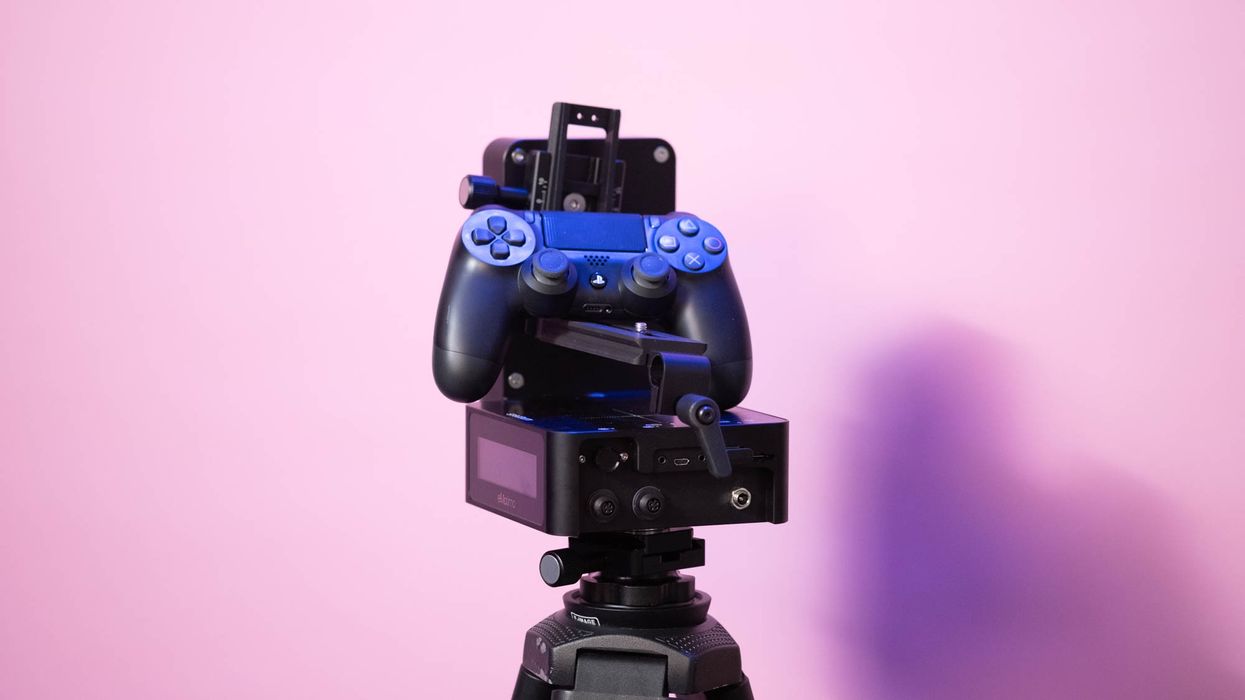eMotimo Spectrum ST Review
Motion Control is becoming affordable for independent productions with the eMotimo Spectrum ST.

Motion Control is the ability to precisely control a cameras position, be that simple pan and tilt or even it's 3D position in space. The key here is that word precisely. Generally with motion control, the dream is to be able to mix together multiple takes of a shot seamlessly, which means each take needs to make exactly. While this can be done with a simple crop for a locked off shot, it's trickier where there is a camera move, which is something modern filmmakers require.
Motion Control is one of those features that we tend to associate with Higher Level/higher budget productions and shows up frequently in the later Back to the Future movies and higher end commercials. On the first shoot we ever worked with it, way back in the year 2001, two guys who had "built the system in their basement" showed up to set with an elaborate motion control rig that required total focus from both of them to execute the shot, and they came to set for only a few short and highly focused hours to execute. It felt elaborate, and expensive, and those hours were all the producers could afford.

In the last few years, a variety of tools for creating "independent" motion control shots have started appearing, though there have usually been limitations either in speed (you couldn't get the camera moving that quickly), or camera weight. Thus, if you wanted a slow moving shot with a 5D, there are affordable options, but if you wanted to fire up a RED package and do repeatable moves that had some hustle behind them, you needed to be prepared to spend a larger amount of money. However, we're starting to see some amazing results even on bigger cameras at affordable budgets and wanted to spend time with one of them, the eMotimo Spectrum ST4, after seeing the amazing results they were getting.
Considering the price point, the ability to carry a 15lb camera package and create those kind of results is a technical wonder. Compared to a lot of other competitors in the space, eMotimo prides themselves on focusing on the whole path of a track, not just the keyframes. After all, even if the keyframes match precisely, if there is wobble between them the shot will still struggle to line up precisely. We found that that that focus on making the full track repeat really paid off in the ability to instantly mix between takes. eMotimo does this by using high-resolution, microstepping motors that hold their trajectory in situations where encoded DC motor system can show drift between passes. Traditionally, steppers in motion control have been noisy and unusable in live environments, but by using the latest driver technology, the spectrum is nearly silent in most modes.
After opening up the eMotimo case for our test, we were able to set up our initial test shot in about 10 minutes.
While a simple shot, the precision of the two takes, and the ability to just stack them in a timeline and cross dissolve between them with no futzing whatsoever, was mind blowing. Many units try to offer something similar, but it's a difficult thing to do and we frequently find ourselves keyframing a reframe to get the lineup to work. The level of precision at the price of the ST4 really impresses. We additionally loved that it was all built into a single unit, with all the cables routed internally, which made for faster and simpler setup.

On top of the standard pan and tilt control, which can be run with either the on camera button through very intuitive menus or through an external remote control, the eMotimo also has two external motor ports, for M3 and M4, which in our setup where used for a "slider" motor to allow for pushing a dana dolly along track, and then also a focus motor. This was a huge benefit, having a single system that also includes focus, and in our opinion is one of the areas that really puts eMotimo ahead of the pack. Any kind of dynamic motion control shot will require focus racking, and being able to program it all together is a huge bonus.
We then set out to put the Emotimo to use in a production, the upcoming webseries SALTY PIRATE. As always, the key is planning. In seconds we were able to execute on a simple shot, and as we planned a more elaborate shot, the rig was there for us, but our blocking wasn't up to snuff. We frankly didn't rehearse our actors enough in pre-production and plan out the precise landing points thoroughly enough. Creative editorial might well save the shot, but we were in a situation where a tool was offering us creative power and we didn't harness it properly . This hits on another key point we wanted to bring up, and that is the time it takes to really learn a tool.
During graduate school, we home built a jib. We used it on everything, constantly. We over used it, for shots where it wasn't needed, until we finally got our "jib-craziness" out of our system, learned how it worked, learned when it helped and when it distracted. It tooks months until we were generally able to really "internalize" jib work. Now, when we see a gratuitous jib shot, it's obvious. "Oh, the director rented a jib that day and hadn't ever used one before" we think, as the jib flies around and around. Really learning a tool takes time, and you need to make a lot of mistakes. We're glad we built that jib and we think it makes us smarter about jib shots decades later.
We think it's time for that sort of integration with motion control. We're big believers in "try and fail and try and fail and try and fail" to get better. Our first jib shot was poorly planned, but now we're better. Our first short was weak, but now we're stronger. Motion Control opens up a ton of opportunities and creative options, but rather than something we get to rent for 4 hours and hope that we planned for properly, we want time to explore and grow. Thus we are so excited it's becoming affordable, and we think it's now time that most filmmakers should consider having something like this in their kit full time.

Establishing Shots
One of the fascinating things that the eMotimo allowed you to do actually isn't about repeatability, it's about extending human functionality. For instance, a common "establishing" shot would be a pan down on a building, with a focus rack landing on the building at the end of the shot. While this usually requires two people (camera operator and focus puller) to time out perfectly, with the ST4, doing it single handed was a snap. Plan out the shot, set up your A frame and your end frame, trigger the unit and a much more sophisticated second unit shot magically appeared while working solo.
This is huge since generally the "second unit/establishing shot" budget is smaller than it used to be. We've done shows where we had 3 people wandering around for 3 days getting those shots, but with smaller budgets and packages, that is often now replaced with "let's send out 1 person for a day," which leads to fewer shots with cool moves and focus racks. However, if you bring along a tool like the eMotimo Spectrum on that day, you can elevate your footage in a way that we hadn't really anticipated.
Quibbles
Our quibbles with the unit are very, very small. The biggest issue is the sensitivity on the on-unit switch. Perhaps it's our meaty fingers, but we keep ending up panning when we met to tilt, and vice versa, with the unit built into the body. Of course, the unit comes with a remote control (from a PlayStation), and that worked perfectly. We recommend the remote so much, in fact, that we chose that image as our "highlight" image above, since this system really comes to life with the remote control.
One odd frustration was the placement of the mounting clip for the focus rod. If you are using a lightweight camera (like the XH1), and a heavier lens, like the Sigma Cine Primes, you are likely to want to mount to the prime lens instead of the camera body. having the rod mount at the same point as the camera mount made it tricky to get a focus motor to reach the lens, since the lens mount and focus ring were so close together. Just be aware, if you are planning on mounting directly to the lens with this system, you might want a cheese plate or a dog leg offset to make it work more smoothly.
We would love a unit that include 4-5 accessory ports, so that we could rig up focus, iris, and zoom motors and a slider motor and some sort of up/down motor, but of course, every user wants everything, and honestly the focus and slider setup did 99% of what we wanted to do and the extra cost of more ports might not be worth it for our rarely it might get used.
We also want to point out that this unit gets way, way easier to use with wireless video. It's not impossible to use without it, but strapping on a Teradek makes a much more pleasant user experience.
Conclusion
Overall, we were blown away. While still a substantial investment for most indie filmmakers, it feels like one that is worth it for a few key reasons. The price point on motion control is such that indies can now afford it, and honestly, we suspect you'll end up finding countless surprising ways to use it, and integrating it into your productions, in a way you wouldn't otherwise. It's time to make this or something like it part of the toolset.
Tech Specs:
- 4 axis of movement (Pan/tilt/M3/M4)
- 15lb payload, unit itself is 4.5lbs
- up to 180 degrees/second pan, 75 degrees/second tilt speed
- 1foot/second max slider speed
- 10.8 - 25.0VDC. 3.5 Amps wall power or V-Mount Battery
- 7.35 x 7.3 x 5" (18.67 x 18.54 x 12.70cm)























